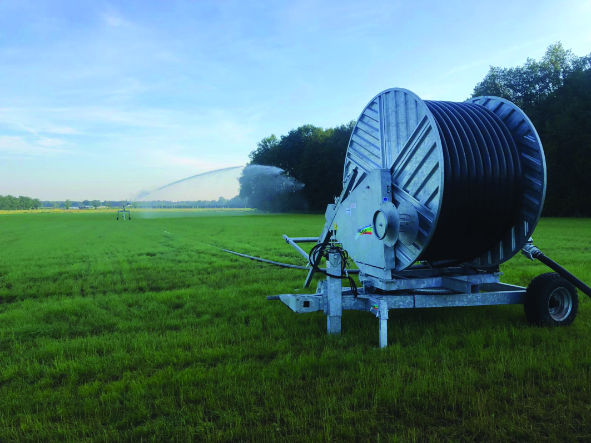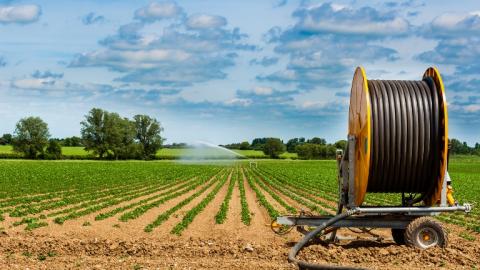Although the furrow method was virtually the only system used in the past, nowadays there is a wide range of irrigation techniques available, such as the pivot, hose-reel and travelling gun or the drip method, allowing the farmer to consider two essential requirements: the performance and durability of the equipment.

The different techniques are not necessarily adapted or adaptable to all crops, making the choice of equipment quite difficult if we consider the different factors that have to be taken into account: climate, soil, crops, energy.
For perennial crops, it is advisable to use a micro-irrigation system, which could be sprinkler or drip. Sprinklers with small-sized droplets would be better suited to compacted (loamy) soils and on soils that are rather sandy in nature, where the wetted bulb is more spread out. On the other hand, drip irrigation would be a perfect match for soils with a low soil water reserve because there is a possibility of making frequent applications of irrigation water.
Furthermore, no shroud of moisture is created, as in the case of sprinklers, because this could carry the risk of mould or mildew for sensitive crops such as tomatoes, peppers and potatoes. In windy regions, drip irrigation holds a definite advantage on account of its capacity to control irrigation uniformity. In regions with a high risk of frost, overhead sprinkling is required, with small droplets and a low flow rate, but this type of irrigation is more often than not used in combination with a below-canopy sprinkler system. In fact, overhead irrigation is not conducive to standard good irrigation practice because of the health risks to the plant caused by the leaves being constantly wetted.
For annual crops, there are two scenarios:
• For market garden crops, both micro-sprinklers and the drip method can be used. Micro-sprinkling will, as noted above, carry the risk of fungal growth on crops that are susceptible to mould or wet rot. On the other hand, it is more recommendable for other crops such as the large family of lettuces and other salad vegetables. In the case of more delicate crops, it would be preferable to use drip irrigation, especially if the plants are grown in a polytunnel. Laying two rows of tubes either side of the seedlings will allow the soil in the tunnel to be cooled and thus maintain a stable temperature, which represents a considerable advantage in Mediterranean regions where the soil temperature can reach almost 70°C during the day. Furthermore, the introduction onto the market of disposable tubes (used for one season) allows for the crop rotation to be varied and avoids the need for tube maintenance, although large quantities of scrap tubing will have to be removed.
• For field crops, the centre pivot and hose reel / travelling gun are the two types of equipment most commonly used at the present time. Making the appropriate choice of such and such equipment will greatly depend on the type of farm and the field size. On a farm divided up into many fields, the hose reel is more appropriate because it is easily moved between fields with the tractor. The adjustment of the angle of the spray gun makes it easily adaptable to the different shapes and sizes of the fields. Furthermore, it makes it easier to vary the crop rotation.
The pivot and lateral move machines, on the other hand, are better adapted to large fields that only require one irrigation application per year. However, the technical progress made on these machines, such as Variable Rate Irrigation (VRI), has produced a good level of irrigation efficiency and an appropriate application rate, its efficiency level approaching that of microirrigation. These two techniques are, on the other hand, less advisable in windy regions and it is recommended that irrigation should be carried out during the night and hourly adjustments made to the rotation so as to limit the effects of wind drift and evaporation losses. The hose reel and pivots also have the advantage that they can be used on a large range of topographies and field shapes.
Drip irrigation is being used more and more on annual crops and perennial crops, such as sugar cane. In order to leave space for tillage, even though it should only be to a shallow depth (<30 cm), subsurface drip irrigation (SDI) is preferred to surface drip irrigation. SDI also allows for smaller doses to be applied on a regular basis in the case of soils with a low soil water reserve and it also enables the irrigation process to be automated. In regions with low rainfall, sprinklers should then be used with SDI so as to increase the application rate and allow the roots to reach the wetted bulb of the subsurface drippers. The burying of the tubes makes it possible to irrigate plots near residential areas or buildings and also those areas of any shape and size that could not normally be irrigated by standard sprinkler methods.

This system, furthermore, is particularly adapted to crops that have been direct drilled (no tillage), also enabling the aeration of compacted soils. Finally, fertigation is possible with SDI, allowing the injection of nutrients directly into the rooting system from a liquid fertiliser tank connected to the pumping station. On the other hand, the seedbed preparation and spacing must be carefully considered beforehand so as to ensure homogeneity of the irrigation and not create a rippling effect, which could have a negative impact on the yield. The crop rotation must then be adjusted accordingly. Care must also be taken to ensure that the soil is of a consistent texture throughout the whole surface of the plot so as to avoid uneven soil water distribution, which could also have a negative effect on the overall yield of the field. The SDI is not actually recommended for fields with more than a 3% slope because of the flow of water that flows towards to the bottom of the slope, depriving the plants situated further up of a satisfactory water intake. Finally, as far as the machinery is concerned, the equipment that is moved around the field (combine harvester, trailers) should have low pressure tyres to prevent soil compaction, as this would impede the capillary action and recovery of the wetted bulb created by the irrigation of the soil.
In conclusion, on the subject of field crops, a total coverage sprinkler system can be installed on fields with a difficult terrain. Having said this, it has to be installed and then uninstalled every year, which can quickly become a serious constraint. Like all sprinkler systems, it becomes very inefficient at wind speeds in excess of 30 km/h. Nevertheless, its flexibility makes it an optimum choice for fields that are difficult to cultivate and it makes crop rotation easier.
At the present time, sprinkler irrigation is still the most common method available on the market, used on almost 80% of irrigated surfaces. Sprinkling, with the introduction of the latest technical advances (VRI, automation), particularly on pivots, allows for a level of efficiency approaching 80-90%, which competes favourably with micro-irrigation. The pivot can be automated with the use of sensors installed in the soil, relaying information to a computer base station, and some operate nowadays with the use of solar energy, resulting in low labour and energy costs. The hose reel, on the other hand, has to be moved to the fields and at the present time it is only automated in a few instances. More labour is thus required.
In all cases, these two techniques consume a lot of energy and require pressures ranging from 7 bar for the travelling gun to 12 bar for the pivot. However, they do not necessarily require high quality water and surface water can be used without the need for filtration beforehand. This is not yet the case for treated wastewater and research is being carried out to determine how the different particles are dispersed after sprinkling. As far as the life span is concerned, the pivot will last longest with an estimated life of 20 years, compared with 7 to 10 years for the hose reel and travelling gun.
Microsprinklers have the advantage of being able to use surface waters (water form the gravity systems) without requiring a pressure greater than 3 bar at the field intake. They are, however, only efficient under certain conditions (see above).
As far as the drip method is concerned, it allows for the irrigation to be automated and there is only a minimum labour requirement during installation and when maintaining the network. The system should be maintained each year in order to avoid the risk of clogging and leakage. The irrigation water has to be filtered, especially when using surface water. Over time, there is a risk with this water, which contains a high level of organic matter, of creating biofilms inside the drippers and even stopping the flow of water. A filter station (screen filter and/or sand filter) upstream of the field is vital so as not to reduce the expected life span of the equipment (estimated at 5 to 10 years).
In addition to the station, sound maintenance is required. With regard to the energy used, a low pressure (1 bar) at the intake of the network is required, which will result in low energy use, even with the frequent applications of water. The energy efficiency (kW/kg harvested) is thus improved.
As far as the disposable tubes are concerned, a water filtration system is still required to prevent the drippers from becoming blocked early in the season.
For all irrigation techniques, it is often useful and even necessary to carry out training programmes in order to increase as far as possible the knowledge of the new products and technical advances in irrigation. This can be organised by bodies such as the Chambers of Agriculture or the information can be summarised in practical fact sheets (e.g. the “Eau Fertile” fact sheets produced by ARDEPI).
There is no magical solution for choosing the irrigation equipment because, within the same production unit, the climatic, pedological and economic conditions can have a varying influence on the techniques that would be the most efficient and long-lasting for the irrigation of a given crop in a given environment.

